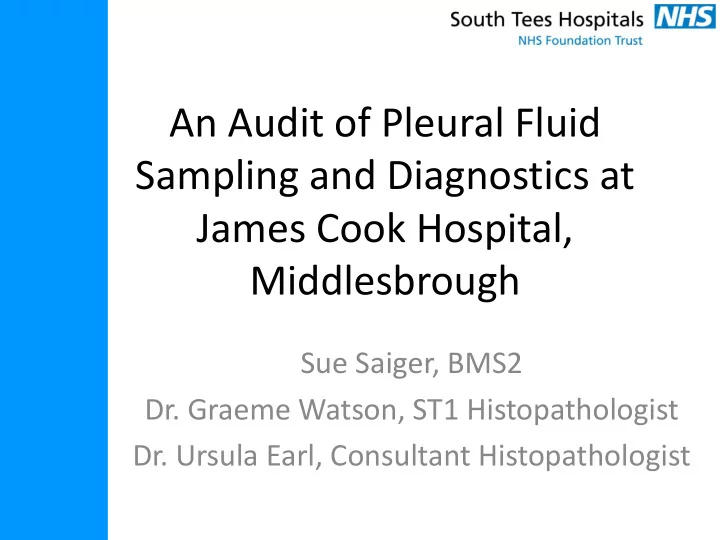

An Audit of Pleural Fluid Sampling and Diagnostics at James Cook Hospital, Middlesbrough Sue Saiger, BMS2 Dr. Graeme Watson, ST1 Histopathologist Dr. Ursula Earl, Consultant Histopathologist
Background: Pleural Fluid Cytology • If respiratory malignancy is suspected in a case of pleural effusion, pleural fluid cytology is a quick and minimally invasive technique to obtain a diagnosis • Yield from sending more than two specimens (taken on different occasions) is low and should be avoided • The diagnostic yield for malignancy depends on – Sample preparation – Experience of the cytologist – Tumour type
Cytology Processing • Up to 40mls sampled • One ThinPrep PAP, one cytocentrifuge Diff-Quik slide prepared • Clots are processed in histology • H&E • Special stains (intracellular mucins) • Immunocytochemistry/I CC (tumour type) • Cell blocks are requested in equivocal cases or where malignancy is suspected to identify cell/tumour type
Background of Audit Topic • Clinical perception at local MDT that pick-up rates for pleural fluid malignancy was low (June 2012). • Laboratory perception that many pleural fluid (PF) samples received were of lower volume than the 20-40mls recommended by British Thoracic Society (BTS) Guidelines 2010. • Lead Pathologist circulated the current BTS Pleural Disease guidance to sample takers. • Laboratory agreement to include a low volume comment when samples received are less than that recommended by the BTS .
Aims of this Audit • An audit of pleural fluid sampling and reporting, with four arms, undertaken in a agreed fixed study periods from 2012-2014 – Determine the proportion of sufficient and insufficient volume PF samples received in a fixed study period – Determine the impact of circulating the BTS guidelines to clinicians involved in PF sampling – Determine any change in malignancy pickup rate – Determine the compliance with an agreed canned comment for insufficient PF samples
Data Collection Method • iLab database search (DBQ) • Figures – Range of volumes of pleural fluids, pre-intervention over a 3 month period starting June 2012 in comparison with 3 months from June 2013 & 2014 – Can we then demonstrate an increase in malignancy pick up rate over 6 month periods June – December 2012, 2013 & 2014 • Laboratory compliance of using minvol canned code when volume received <20mls – June – Aug (Dec) 2013 – June – Aug (Dec) 2014
Results
The Proportion of acceptable (≥20mls) to unacceptable (1 -19mls) pleural fluid volume samples received in the months of Jun-August (2012-2014) 2012 15 33 2013 Year 55 28 >20ml 1-19ml 2014 46 15 0% 10% 20% 30% 40% 50% 60% 70% 80% 90% 100% Percentage In the fixed June-August period from 2012-2014, there has been an improvement in that 30% of PF samples received were of sufficient volume to around 75%
Graph to show proportion of malignancies detected in pleural fluid samples between the months of June-December 2012-2014 2012 23 122 2013 Year 28 156 Malignant Non-malignant 2014 35 156 0% 10% 20% 30% 40% 50% 60% 70% 80% 90% 100% Percentage In the fixed June-December period from 2012-2014, there has been a small increase in the number of malignancies detected in PF samples, from 16% to 19%
Graph to show proportion of low volume samples labelled with canned minvol comment in each August (2012-2014); NB Canned comment not in use during 2012 2012 0 32 Number of low volume samples with 2013 Year 14 16 minvol comment Number of low volume samples without minvol comment 2014 2 13 0% 20% 40% 60% 80% 100% Percentage In 2012 a canned comment for minimum sample volume was not in use; Implemented in 2013 the code was included in >40% of minimal volume PF specimens, but 2014 was only included in ~13%
Conclusions • In the study period, sufficient volume of PF sample has increased from 30% to around 75% • The intervention of distributing PF volume sample guidance appears to have had a positive effect • There has been a small increase in the number of malignancies detected in PF samples from 16% to 19% (19% increase), but a 31% increase in PF samples received in the fixed study period in 2012-2014 • A canned reporting comment was not in use in 2012. Despite inclusion in ~40% of minimum volume PF samples in 2013, this dropped to ~13% in 2013
Future • Re-circulating pleural fluid volume sampling guidance to acute medicine and respiratory divisions • Re-communicate use of the minimum volume comment to lab staff • Re-audit following these further interventions
End
Recommend
More recommend